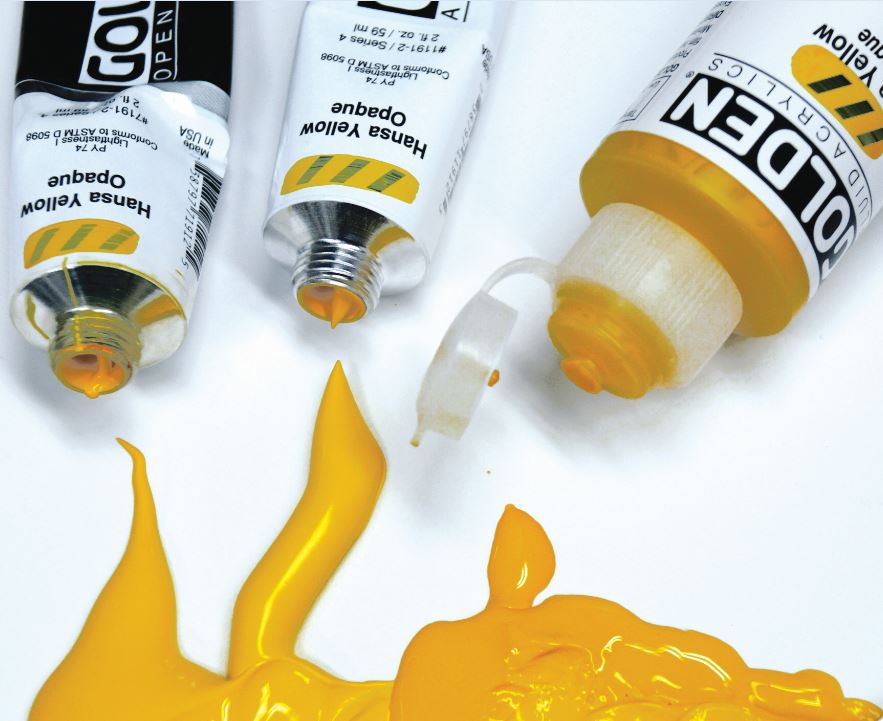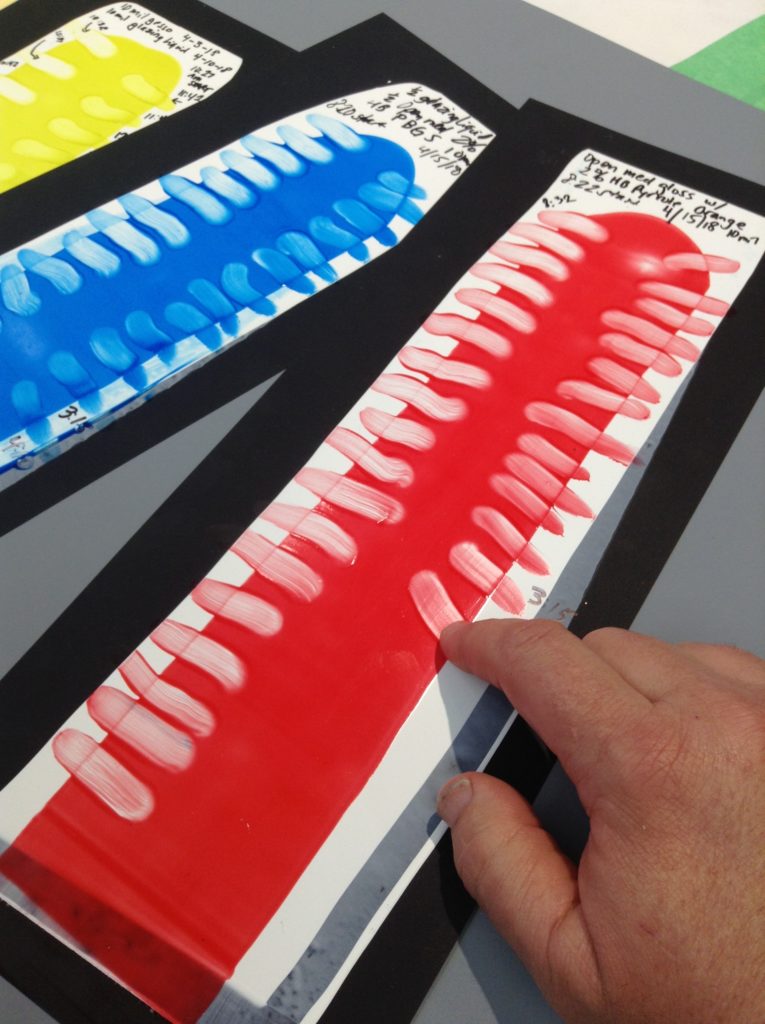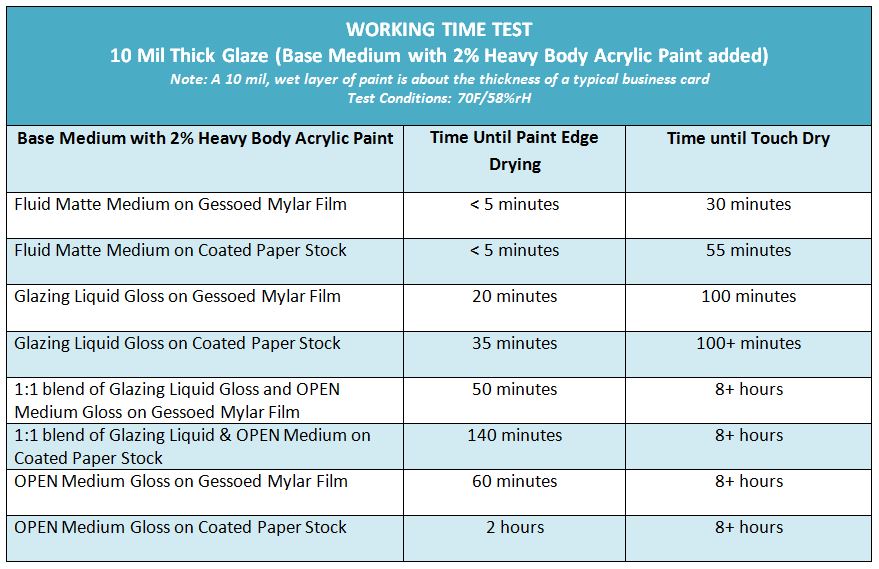
The key to controlling working time in acrylics lies in the ability to control the rate of evaporation of water. Once most of the water is gone, so is the ability to manipulate the paint layer. Therefore, in order to control acrylics one must control the water. This becomes increasingly important to be able to move from fast drying paint mixtures to slower drying paints as needed. Fast drying layers work well in the early stages of a painting to be able to block in color sections, and then gradually slow down the drying rate when blending and color gradation is required.
GOLDEN produces both fast drying paint lines such as Heavy Body and Fluid Acrylics, and the very slow-drying OPEN Acrylics. These paints are inter mixable and one can control the working time this way. However, it seems unreasonable to ask artists to maintain a steady supply of two paint lines, so the more realistic approach is to start with one paint line and modify it with a series of mediums.
Before we get into the mediums, let’s address the other key factors that alter painting time.
Factors Influencing Working Time:
- Painting Surface Absorbency – Absorbent surfaces rob the paint of water and retarder, so well-sealed surfaces increase painting time.
- Humidity – When there is more water in the studio atmosphere, the water in the paint evaporates more slowly. Arid climates are known to wick both water and retarder out of the paint.
- Air Movement – Wind, fans, central air systems, even people walking by can help pull water out of the paint.
- Temperature – Although temperature is often thought of as a main drying factor, it’s not as important as others, such as humidity and air flow.
- Paint Layer Thickness – Thin paint layers are going to dry faster than thicker ones due to drying uniformly. OPEN additions greatly reduce skinning over.
The above factors cannot always be precisely controlled while painting, but being aware of them while painting and afterwards can make a big difference in working time and how long you’ll need to wait for paint to dry.
The Trick is in the Mix
While the OPEN products allow for a much more leisurely pace while painting, using only these paints means you have to wait much longer for each paint layer to dry before proceeding, similar to working in oils. Thankfully, OPEN is completely compatible with the rest of the GOLDEN staple of products! This offers the ability to adjust and dial in the amount of time you need to apply each brush stroke.

A Paint Schedule to Maximize Drying Times
“Paint schedule” refers to the process used for commercial applications like wood stains and car finishes. Here’s a schedule that gradually provides increased working time, yet provides underlying layers to dry quickly:
- Use a medium to seal the surface absorbency. For example, gessoed canvas is fairly absorbent. Use Fluid Matte Medium over the entire painting.
- Continue using Fluid Matte Medium with some paint to begin composition. Block in areas with a base color for the main parts of the painting. You can use other mediums too!
- Swap Fluid Matte Medium with Glazing Liquid as more details are further developed. Glazing Liquid improves the working time to about 10-15 minutes on the sealed surface.
- As more blending time is required, gradually include a little OPEN Medium into the paint mixtures. Increasing OPEN Medium mirrors the improved painting time, but the paints still set up and can be painted over relatively quickly.
- Completely replace Glazing Liquid with OPEN Medium. When the majority of the mixture is OPEN Medium (more than half), working time improves to 45 minutes to an hour. Longer drying time before repainting is now required.
- Replace standard paints with OPEN Acrylics. As a system, OPEN products increase working time to an hour plus, and remain working for many hours more. Waiting until the final stages to convert allows for all of the subtle details that make the painting complete.
Using fast drying products in the beginning stages allow for a rapid buildup of both color and medium, both serving to seal the absorbency more than thin color washes on gesso. In turn, this foundation provides more blending time as details continue to be added in. Even if you wish to start off creating soft edges, shadows, and color blends, be sure to seal the surface with Fluid Matte Medium or a gloss medium/gel if the glare isn’t too distracting for you.
Note: Jumping around between mediums while painting is possible, but realize that any slow-drying layers will take longer to dry before you can paint over them without lifting partially cured paint layers.
The below table gives a good guideline for general timelines for what kind of working time you’ll have when working on a semi-absorbent and a sealed surface.

Blending Standard Acrylics with OPEN Acrylics
Although the presented painting schedule highlighted the use of mediums to adjust working time, the specific products used are up to each artist. For example, if you already own a fair amount of GOLDEN Heavy Body Acrylics, use them with the various mediums. The same goes for GOLDEN Fluid Acrylics or even GOLDEN High Flow Acrylics. There’s no need to also get a set of OPEN Acrylics if the required working times are being met. However, if the longest possible working times are more critical for your painting style, then OPEN Acrylics modified with OPEN Medium, OPEN Thinner or Glazing Liquid are the better option. The key takeaway is that all of these products are completely compatible.
Further Reading:
https://justpaint.org/extending-the-acrylic-range-developing-open-acrylics/
https://www.goldenpaints.com/technicalinfo/technicalinfo_openmeds
https://www.goldenpaints.com/technicalinfo/technicalinfo_opendrytime
https://www.goldenpaints.com/technicalinfo/technicalinfo_drying
https://justpaint.org/suggested-drying-times-between-acrylic-layers/
https://justpaint.org/understanding-and-controlling-acrylic-drying-time/
https://justpaint.org/investigating-the-drying-process-of-acrylic-color-and-gel-medium/
About Michael Townsend
View all posts by Michael Townsend -->Subscribe
Subscribe to the newsletter today!

Thanks for this study. My adult students will appreciate the structured approach to to information.
Thank you Kristine!
– Michael Townsend
Hi Michael,
Thank you for all your research and time spent dissecting the paint process. I am trying to find a pourable acrylic paint (paints) that I can pour on thick in different patterns – (say maybe 1/8″ thick) and have it dry nice, self leveling and without any wrinkle, or orange peel… I have tried multiple paints from even hardware stores, art stores, but am having some difficulty..
can I only achieve this by applying smaller layers one at a time to build it up?
JP. Have you tried the 10:1 GAC 800 and Fluid Acrylic mixtures? – Mike Townsend
I’m going to paint a Buddha statue with acrylic pain. What’s the process I should use to prepare the statue, made out of plaster (which is a dark patina)
Hello Felipe.
Thank you for contacting us with your questions.
We have another Just Paint article that describes painting acrylics onto plaster, located here: https://justpaint.org/painting-plaster-with-acrylics/.
Please review the article and get back to us if you have any additional questions.
Regards,
– Mike Townsend
Love ur paints and other products this site is so informative and helps me a lot. I have always dabbled in painting but lately have really picked up fluid art and love it so the vibrant color paints really turn me on!
Thank you Eddie!
– Mike Townsend
Very helpful!!! Thanks for the insights!
Thanks Kirah!
– Mike Townsend
Great article since the paint medium has always been a key to whether my art projects actually turn out well of not. I really like this article I found from VeryCreate.
https://verycreate.com/one-landscape-painted-with-3-different-mediums-demonstration/
I was curious if you have ever done any kind of test with basically the same art project with a few different art mediums. I am leaning more to acrylics today but have loved watercolor for years. Appreciate your thoughts!
Thank you, Mark.
We have not done such an article to compare various media as you suggest, but we do appreciate the suggestion for a future article!
– Mike Townsend
Does Golden offer a very thick retarder to mix with the Artist line of acrylics? Also, do you have a clear medium or gesso to seal a graphite drawing on canvas?
Hi Jerry.
Thanks for your questions. Our Retarder is more viscous than most in the marketplace. We wanted to make one that didn’t overly thin the Heavy Body Acrylic Paints. If you needed to have your mixture be even thicker, blend the paint first with something like Extra Heavy Gel, or High Solid Gel, to increase the overall viscosity.
You can use the GOLDEN Fluid Matte Medium to seal graphite drawings. I start with a relatively small flat brush, and brush in the direction of the linework. You will get a bit of smearing, but I find that you can use this to your advantage and create some soft shadows. After the lines are seal, you can switch to a wider brush if you need to unify the entire surface. You can use this product as a clear gesso as well.
– Mike Townsend
Thank you. Your answers are always clear, fast, and accurate. It’s a pleasure to chat with you.
You are most welcome, Jerry!
Please view this youtube address. https://www.youtube.com/watch?v=k8NLmGNndcI
Like this artist, for years painted in oils and for health reasons switched to acrylics, specifically Golden. I like painting wet on wet and want to maximize the open time. The above video shows how he is doing just that. I respect your expertise and ask for a solution to my dilemma.
Hello, Jerry.
Thanks for your questions and comments.
Retarder is certainly a good option to work with when you need a good covering color, and that can be done fairly easily. Some artists prefer Retarder, others like the Glazing Liquid as you can add as much as you desired. However, Retarder/Glazing Liquid can only provide about 15 minutes or so of working time before you need to replenish the lost water. OPEN Medium used with the standard acrylic paints can provide even greater working time, and OPEN Medium with OPEN Acrylics therefore can provide the longest working time for wet into wet blending. The use of a Medium compared to an Additive (Retarder) is important because mediums can be used with far less concern than an additive because additives do not provide any binder. In the video, the amount of Retarder being used is still reasonable for thinner applications.
Again, thank you for your questions and we are working on another Just Paint Article that I hope helps further explain the use of Retarder!
Regards,
– Mike Townsend
Thank you very much for a great article!
I use fluid acrylics a lot, which are obviously not open acrylics. I use them with all sorts of mediums depending on the fluidity I want (soft or regular gel gloss, GAC 500, Gac 800).
Can I lengthen the working time of these mixes by adding open medium to them, or would that be asking for trouble? (given that Open medium is intended to extend open acrylics, and these aren’t open ones)
Hello Syb.
Thanks for your comments. The various mediums are compatible with OPEN products, so that’s not the issue. It is usually how thickly you apply the mixture. For example, if you use GAC 800 for pouring, the thick layer might remain tacky for days or sometimes even weeks depending upon the amount of OPEN used. But thinner, brush-applied applications should not pose an issue. – Mike
The article was very helpful, but I loved the picture of father and child. Classic.
Does the color shift still happen when the open paint dries? Please describe the types of mediums and retarders to use with the Heavy paints as that comprises my current paint supply and experience.
Thanks Jerry. That’s me, holding my son from circa 2008, back when he was small enough that I could!
OPEN still has some color shift, but what I have observed is that it happens so slowly in both the paint on the canvas and on the palette, that you don’t notice it as much as you do when you paint with the other paint lines or use fast drying mediums. OPEN dries differently. It doesn’t skin over like most acrylics at the start. It slowly thickens. So before it becomes touch dry (sometimes many hours later) the wet paint resembles the drying paint layer. After 3 or 4 days, then you might notice the color shift as fresh paint is applied on top. Of course, the pigments used and overall formula factor in with color shift as well.
– Mike Townsend